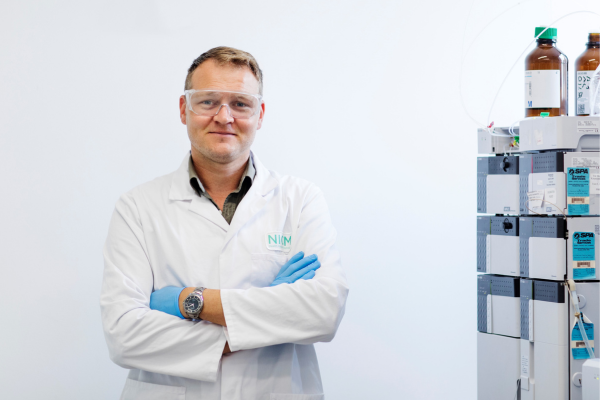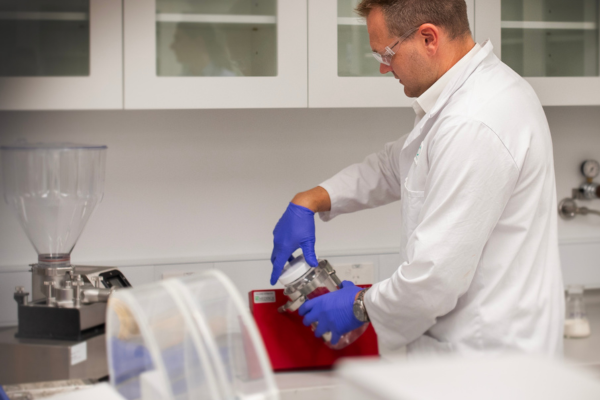Researcher showcase: Dr Mitchell Low, Postdoctoral Research Fellow

Dr Mitchell Low has worn many hats in his 10 years at NICM: Laboratory manager of our GMP testing laboratory, Research Fellow and Higher Degree Research supervisor. He’s led 60 research projects, advanced the field of natural products with more than 25 peer-reviewed publications, and has multiple patents associated with his research.
Throughout this time, his work at NICM has been driven by one overarching question: Can the essence (active ingredients) in natural products be defined, controlled and enriched to provide acceptable and effective medicines?
Now we’ve asked a few of our own questions to find out how Dr Low got into health research, the vital role analytical chemistry plays in the field of complementary medicine, and his recent work identifying, purifying and trialling an Australian plant active that could be a game-changer for treatment-resistant mental health disorders.
What inspired you to get into health research?
My research initially was laboratory based, and I was inspired by scientific curiosity. When it came to natural medicines my initial question was ‘do they work?’. Once I became more acquainted with the evidence, I began to question why I had that initial scepticism.
I found that when it came to natural products like cannabis, coffee and tobacco, I had no issue believing that they had a biological effect, but with others my default response was sceptical.
The definition of the active ingredient seemed to provide the scientific support that helped me to understand the natural effect and accept natural medicines as functional natural products. So, I pursued this same principle in my early research investigating the anti-inflammatory compound andrographolide – the active ingredient in Andrographis paniculata (also known as creat or green chiretta).
What is analytical chemistry and why is it so important to the field of complementary medicine?
Analytical chemistry is determining ‘what’ and ‘how much’ of a substance is in a sample. It is the separation, identification and quantification of entities in different matrixes.
In natural medicine research this typically involves quantifying compounds in the natural source (plant, mushroom, oil etc), during manufacturing steps, in the final product, in the product at expiry, in cellular models and in humans or animals once ingested. This includes active ingredients, co-factors and undesirable compounds.
It also involves quantification of biological disease and physiological markers.
This work is essential to control the dose, quality and safety of products and to determine if the ingredients reach the site of action in the body and have a biological effect.

A lot of your current research is in the emerging field of psychedelic-assisted therapies. Can you share some of your recent findings in this space and why they're significant?
I think the area of psychedelic-assisted therapies has huge potential to help overcome life changing trauma from lifestyle, work or events outside a person’s control. Emerging evidence suggests the mind opening experience may help to hit the reset button, which could lead to treatments that are more effective than ongoing, expensive conventional therapy.
The first-generation drugs in this field are showing good broad efficacy, however as the science progresses tailored drug options will improve treatment possibilities.
My team has been identifying and quantifying different natural psychedelics to support research and development of multiple psychedelic treatment options.
An example of this is our recent publication in Forensic Chemistry, on the identification and quantification of psychedelic mescaline in cactus. We report on the mescaline content in species both known to contain mescaline and species not previously known to contain mescaline.
Our group has also made some other recent publications on improving safety and scientific definitions, which are important for the development of safe, ethical and effective psychedelics for psychedelic-assisted therapies. You can read these here and here.
You recently collaborated with CSIRO, can you share more about this work?
The use of psychedelic drugs in conjunction with therapy has shown good clinical outcomes in treating mental health conditions that have not been able to be resolved with conventional drugs and therapy. Conditions like PTSD, depression and addiction, have been overcome with long lasting effects. One of these natural psychedelics is Dimethyltryptamine (DMT), which has been used traditionally as the psychedelic Amazonian tea Ayahuasca.
I recently worked with the CSIRO and Neurala Biosciences (formerly the Psychae Institute) to develop an Australian version of Ayahuasca (in pill form) to administer in early phase psychedelic-assisted psychotherapy trials at St Vincent's Hospital Melbourne.
I identified DMT in Australian plants and our team developed its extraction. Working alongside the CSIRO we were able to refine the process which achieved 99% purified DMT.
Now, Phase 2 trials are in preparation with scaled up manufacturing at IDT Australia. If successful, this novel Australian plant active based treatment could have huge potential to reduce the cost of treating these debilitating mental health disorders that would otherwise involve a lifetime of therapy and drugs.
Interested in learning more? You can find more information about Dr Low’s research and recent findings here.
